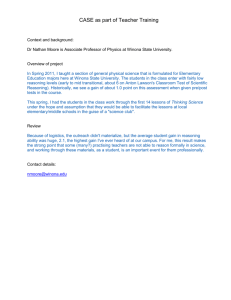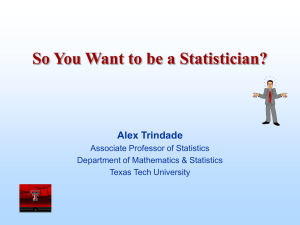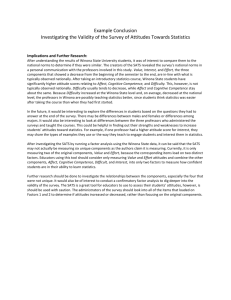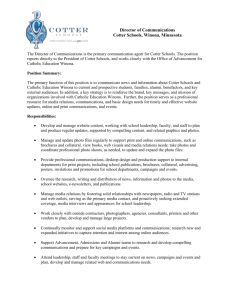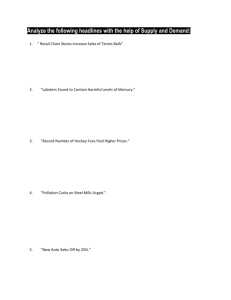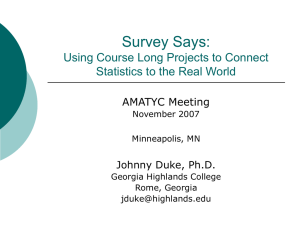Careers in Statistics - Winona State University
advertisement
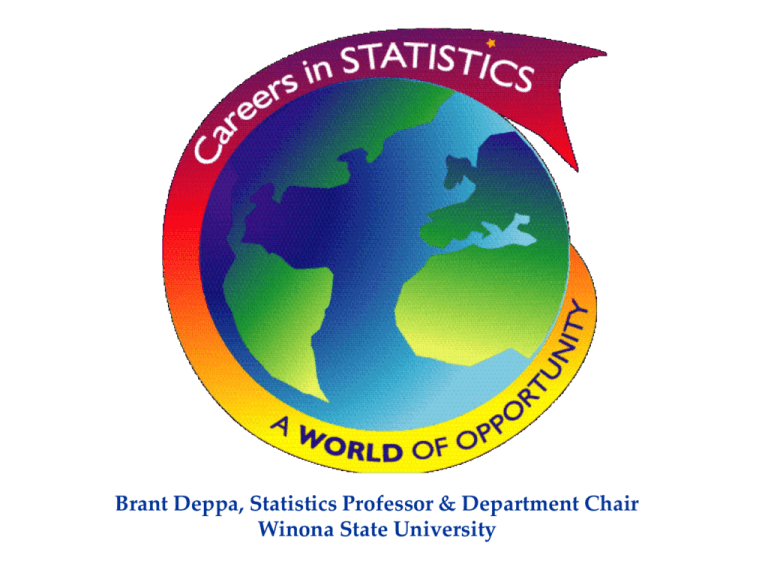
Brant Deppa, Statistics Professor & Department Chair Winona State University What Is Statistics? • Put simply statistics is the Science of Data (i.e. data science) • Statisticians collect, describe, present, and draw conclusions from data. Business Economics, Engineering, Marketing, Computer Science Health & Medicine Genetics, Clinical Trials, Epidemiology, Pharmacology Areas where STATISTICS are used Physical Sciences Astronomy, Chemistry, Physics Environment Agriculture, Ecology, Forestry, Animal Populations Government Census, Law, National Defense Why Study Statistics? Why Study Statistics? The top four jobs according for Forbes Magazine Why Study Statistics? • Collecting data on subsets of the population (samples) can give valid information about the whole population. • Knowing what has happened in the past can help answer questions about the present and future. Prediction! • Knowledge helps plan future tests, determines resource allocation, and improves outcomes. What Do Statisticians Do? • Develop methods for predicting customer behavior. • Evaluate the environmental impact of pollution • Determine the effectiveness of new drugs and medical procedures. • Plan and analyze industrial and agricultural experiments. What Can I Do With A Degree in Statistics? Where do statisticians work? Business and Industry • Manufacturing – Build products and deliver services that satisfy consumers and increase the corporation’s profit margin Business and Industry • Marketing – Design experiments for new products, conduct sample surveys, and perform field experiments in test markets to determine product viability. Develop models to predict customer behavior. Business and Industry • Engineering – Make a consistent product, detect problems, minimize waste, and predict product life in electronics, chemicals, aerospace, pollution control, construction, and other industries. Business and Industry • Statistical Computing – Work in software design and development, testing, quality assurance, technical support, education, marketing, and sales to develop code that is both userfriendly and sufficiently complex. Programming with BIG DATA! Health and Medicine • Medicine – Design and analyze data from clinical trials to improve patient outcomes (e.g. Mayo Clinic). Health and Medicine • Epidemiology – Work on calculating cancer incidence rates, monitor disease outbreaks, and monitor changes in health-related behaviors such as smoking and physical activity Health and Medicine • Public Health – Prevent disease, prolong life, and promote health through organized community efforts, including sanitation, hygiene education, diagnoses, and preventative treatment Health and Medicine • Pharmacology – Work in drug discovery, development, approval, and marketing, to ensure the validity and accuracy of findings at all stages of the process Health and Medicine • Genetics – Label possible indicators of genetic abnormalities, such as birth defects and diseases, or use genetic information to optimize patient treatment. Learning • Education – Teach K-12 through postgraduate students, assess teacher effectiveness, or develop statistical models to represent student learning. Learning • Science Writing & Journalism – Work with mass media, universities, and corporations to produce news briefs, articles, news releases, and other reports Research • Government – Work in regulations for stock trading, pollution, and drug approvals, or testify in court proceedings, congressional hearings, and lobbying arguments Research • Survey Methods – Collect data in the social sciences, education, law, forestry, agriculture, biology, medicine, business, and e-commerce, and for the government Social Statistics • Law – Analyze data in court cases, including DNA evidence, salary discrepancies, discrimination law suits, and disease clusters Social Statistics • Consulting – Work on a temporary basis on a variety of projects including quality improvement, pharmaceuticals, ecology, and engineering Natural Resources • Agriculture – Study chemical pesticides, hydrogeology, veterinary sciences, genetics, and crop management in order to ensure optimal yield Natural Resources • Ecology – Address questions about the earth’s natural environment, including global warming, study of animal populations, agricultural issues such as fertilizer and pesticide safety. How Do I Become A Statistician? Education • High School – Study statistics, mathematics, science, computer science, and English • College – Major in statistics or applied mathematics WSU – B.S. Statistics and B.S. Data Science • Post-Graduate – Many career fields require a Master’s degree or Ph.D. in a specialized statistical field Skills • Quantitative Skills – Statistics, Mathematics, Science • Problem Solving Skills – Analysis, Teamwork, Intellectually Curious • Communication Skills – Verbal, Written • Computer Programming Languages • Foundation in Field of Application Opportunities • Diversity – Pure research – Interdisciplinary teams • Advancement – Experience, education, and communication skills lead to professional advancement • Versatility – Challenging and exciting fields of application Salaries and Job Growth Salaries and Job Growth Salaries and Job Growth Starting and Mid-Career Salaries Highest Degree Starting Mid-Career Bachelors $52,500 $86,500 Masters $75,000 $125,000 Doctorate $107,000 $172,000 Salaries and Job Growth Salaries and Job Growth And Always Remember… THERE IS STRENGTH IN NUMBERS! And Always Remember… The more math you take, the more money you make! Want to learn more? • Great website to learn about the statistics profession: www.thisisstatistics.org • Current job listings in statistics/data science icrunchdata.com indeed.com (Keywords for either: statistician, data analyst, data scientist) • Great free course in data analysis (MOOC) https://www.futurelearn.com/courses/data-to-insight Want to learn more? Contact us: Brant Deppa, Ph.D. course1.winona.edu/bdeppa Professor and Department Chair Mathematics and Statistics Winona State University bdeppa@winona.edu Nicole Williams, Ph.D. Professor, Dept. of Mathematics & Statistics Winona State University nwilliams@winona.edu
